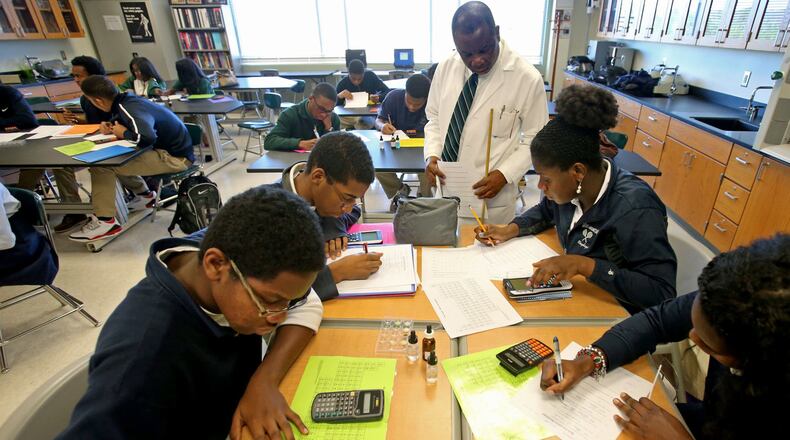EXPLORE THE DATA
Look up your high school's or school district's graduation rate on the searchable database the AJC has put together to serve our readers. You can find it only on myAJC.com.
Georgia’s public high school graduation rate has continued to rise, but more than a quarter of the state’s students are still failing to make it out into the real world with a regular diploma within the allotted four years.
The graduation rate for 2014 was 72.5 percent, according to figures released by the Georgia Department of Education Thursday. That’s up from the prior year but by less than a percentage point. And the upward trajectory of prior years is starting to level off.
State School Superintendent John Barge celebrated another year of increases.
“When we see the graduation rate consistently trending upward and when we see a greater percentage of our students graduating from our public high schools, we are talking about individual students and individual dreams,” he said in a statement.
» SEARCHABLE DATABASE: Georgia's graduation rates
Some had a more sobering assessment, observing that the trend isn’t all upward. The rate of increases has begun to stall, making Georgia seem kind of like the Little Engine That Could as it struggles up the mountain. The 2014 graduation rate increase was a third as big as in each of the prior two years, when the rate climbed at least 2 percentage points annually.
And buried in the numbers was more troubling news: the graduation rate of Georgia’s high-poverty students, an ever-growing group, actually decreased, to 62.5 percent. It wasn’t a big decline, but it was a move in the wrong direction for what is now the majority of students, with those from low-income households comprising 62 percent of the 1.7 million enrolled. That demographic has been growing at a blistering pace since the recession, up from 53 percent in 2008.
“That is one of the fastest growing subpopulations, and the fastest growing subpopulation declining is a real concern for us,” said Stephen Dolinger, president of the Georgia Partnership for Excellence in Education.
Ann Malkoc, whose son is a second-grader in an elementary school in central Gwinnett County, was disturbed by the rate at Berkmar High, where her son, a second-grader, could attend. The graduation rate was 57.8 percent. “That’s just appalling if you ask me,” said Malkoc, a PTA leader.
The graduation rate in Gwinnett, Georgia’s largest school district, rose slightly from 72.7 percent to 75 percent. “We’re certainly pleased with the progress, but we want much more,” said Kevin Tashlein, an associate superintendent for Gwinnett. “We know there’s a lot of work to do.”
This year, Gwinnett started career academies at five high schools with lower graduation rates. Tashlein said the academies weren’t created specifically to improve the rates, but he said positive reaction from students will raise performance and help more get their diplomas.
Georgia began using a new method to calculate the graduation rate beginning in 2011. Known as the “adjusted cohort rate,” it counts the group of students who started together as freshmen and completed high school within four years.
The method— now required by the federal government — caused a steep decline in official graduation rates. While Georgia has been consistently clawing its way back up, the state has routinely ranked near the bottom among the states. Only New Mexico and Nevada had lower rates than Georgia in 2011, when the U.S. Department of Education released a state-by-state breakdown under the new method. It’s unclear how Georgia has ranked more recently, since states release graduation rates at different times.
Barge said regional differences still make comparisons problematic. Georgia has higher academic standards than many others, he said, “so our graduation rate typically doesn’t look very good when compared to the nation.”
Georgia does require more to graduate than most of its neighboring states: four credits of English, math and science. Seven of the 16 states whose data and education trends are tracked by the Southern Regional Education Board do not require that much.
Some schools managed steep increases despite apparent disadvantages. Lithonia High in DeKalb County had a 9.7 percentage point increase despite a poverty rate of 82 percent.
Principal Yolanda Peek attributes the increase to high expectations expressed in the “data talks” she and her administrators have with students. Counselors assemble a dossier on each, highlighting good grades in green, average in yellow, and failing in pink. “Some of them, for the first time, were going ‘Wow, I have a lot of work I need to do,’ ” Peek said.
Cory Carter, a senior there, said the school has ramped up the support from counselors and others since his freshman year.
“They provided more tutorials, brought in more people to talk to us and help us,” he said.
Jack Parish, a retired Henry County school superintendent, was encouraged by the “positive trajectory” since the big drop in 2011. Now an associate dean in the College of Education at the University of Georgia, he said graduation rates can be improved with early literacy programs, after-school and summer educational programs and mentoring and easing the often difficult transition from middle to high school.
» LEARN MORE: Visit our Education page
About the Author
Keep Reading
The Latest
Featured




